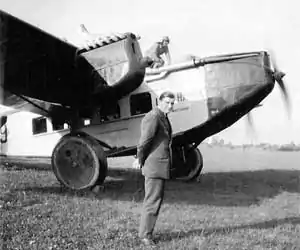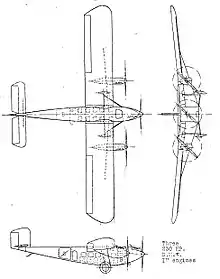Rohrbach Roland
The Rohrbach Ro VIII Roland was an airliner produced in Germany during the 1920s.[1] It was a conventional strut-braced, high-wing monoplane, based loosely on the Zeppelin-Staaken E-4/20 that Adolf Rohrbach designed in 1920.[2] It had a fully enclosed flight deck and passenger cabin, and featured fixed, tailskid undercarriage.[2] Power was supplied by three engines, one in the nose, and two mounted in nacelles on the wings.[2] Construction was of metal throughout.[3]
| Ro VIII Roland | |
|---|---|
 | |
| Role | Airliner |
| National origin | Germany |
| Manufacturer | Rohrbach |
| Designer | Adolf Rohrbach |
| First flight | 1926 |
| Primary user | Deutsche Luft Hansa |
| Number built | 18 |
Design and development
In 1926 Deutsche Luft Hansa purchased the prototype Roland, followed by five production examples over that year and the next.[4] The production machines were built with open flight decks, although they were later enclosed, as on the prototype.[4] These were put to work servicing a route between Berlin and London via Hanover and Amsterdam.[4] In July 1927 the Roland held the world endurance record for a payload of 1,000 kg with a flight of 14 hours 23 minutes,[4] and the world distance record for a payload of 2,000 kg of 1,750 km (1,090 mi).[5] At different times, the Roland held twenty-two world records.[6]
In 1928, Luft Hansa replaced three of its Rolands with new machines of slightly different design. Designated Ro VIIIa, these had a fuselage that was stretched by 30 cm (1 ft) and were powered by the more powerful BMW V engines in place of the BMW IVs fitted to the prototype and first production batch.[4] A new Spanish airline, Iberia, purchased the three Rolands that Luft Hansa retired, and put them into service on its inaugural service between Madrid and Barcelona.[4]
In 1929, Rohrbach produced nine examples of a substantially updated Roland for Luft Hansa.[4][6] These featured a major redesign of the flight deck, and a new wing design.[4] Dubbed the Roland II, these aircraft continued in service with the airline until 1936 on its Hamburg–Malmö and Berlin–Munich routes.[4] Luft Hansa sold at least three of these aircraft to Deruluft upon retirement.[4] The Luftwaffe acquired another one, armed it, and operated it at the clandestine school at Lipetsk to train bomber crews.[7]
During his 1932 election campaign, Adolf Hitler hired a Rohrbach Ro VIII Roland aeroplane from Deutsche Luft Hansa for his two first series of campaign flights in March and July. The aeroplane was named Immelmann I after World War I pilot Max Immelmann. Hitler switched to a Ju 52 in November 1932.[8]
Popular culture
The Spanish amusement park Tibidabo (Barcelona) got a real-size replica of that plane, painted red. It is the most famous ride in the park, opened on September 23, 1928, sometimes referred to as "the first flight simulator in the world", and called "L'avió" (Catalan for "the plane").
Variants
Data from:German Aviation 1919 - 1945[9]
- Ro VIII Roland I
- Initial version powered by three 250 PS (246.58 hp; 183.87 kW) BMW IV 6-cylinder in-line water-cooled engines.
- Ro VIIIa Roland Ia
- Three aircraft purchased by Deutsche Luft Hansa, with a 0.30 m (1 ft) fuselage stretch, powered by three 360 PS (355.08 hp; 264.78 kW) BMW V 6-cylinder in-line water-cooled engines.
- Ro VIII Roland II
- A significantly up-graded version for Deutsche Luft Hansa, with revised cockpit and re-designed wing, powered by three BMW V engines; nine built.
Specifications (Ro VIIIa Roland Ia)

Data from Jane's all the World's Aircraft 1928[10]
General characteristics
- Crew: 3 (2 pilots + 1 engineer)
- Capacity: 10 pax
- Length: 16.4 m (53 ft 10 in)
- Wingspan: 26 m (85 ft 4 in)
- Wing area: 88 m2 (950 sq ft)
- Empty weight: 4,900 kg (10,803 lb)
- Gross weight: 7,400 kg (16,314 lb)
- Powerplant: 3 × BMW Va six-cylinder in-line water-cooled piston engines 240 kW (320 hp) - 270 kW (360 hp) each
Performance
- Maximum speed: 204 km/h (127 mph, 110 kn)
- Cruise speed: 165 km/h (103 mph, 89 kn)
- Landing speed: 106 km/h (66 mph; 57 kn)
- Service ceiling: 4,200 m (13,800 ft)
- Time to altitude: 1,000 m (3,300 ft) in 5.5 minutes; 2,000 m (6,600 ft) in 13 minutes
- Wing loading: 84 kg/m2 (17 lb/sq ft)
- Power/mass: 0.0973 kW/kg (0.0592 hp/lb)
References
- Taylor, Michael J. H. (1989). Jane's Encyclopedia of Aviation. London: Studio Editions. p. 768. ISBN 0-7106-0710-5.
- The Illustrated Encyclopedia of Aircraft. London: Aerospace Publishing. p. 2816.
- Munson, Kenneth (1982). Airliners from 1919 to the Present Day. London: Peerage Books. pp. 137–138. ISBN 0-907408-36-2.
- Munson 1982, p.138
- "World's Records in Aviation". Flight: 247. 20 March 1931. Retrieved 2009-01-31.
- "The Rohrbach 'Roland II'". Flight: 434. 23 May 1929. Retrieved 2009-01-31.
- Johnson, Robert Craig (December 1998). "Planting the Dragon's Teeth". Chandelle. 3 (3). Retrieved 2009-01-31.
- Hoffmann, Peter (2000). Hitler's personal security : [protecting the Führer, 1921-1945] (1st Da Capo Press ed., [2nd ed.]. ed.). [New York]: Da Capo Press. p. 72. ISBN 978-0306809477.
- "Rohrbach Ro VIII Roland I and Roland II". histaviation.com. Retrieved 8 February 2018.
- Grey, C.G., ed. (1928). Jane's all the World's Aircraft 1928. London: Sampson Low, Marston & company, ltd. pp. 145c–146c.
External links
| Wikimedia Commons has media related to Rohrbach Ro.VIII Roland. |
